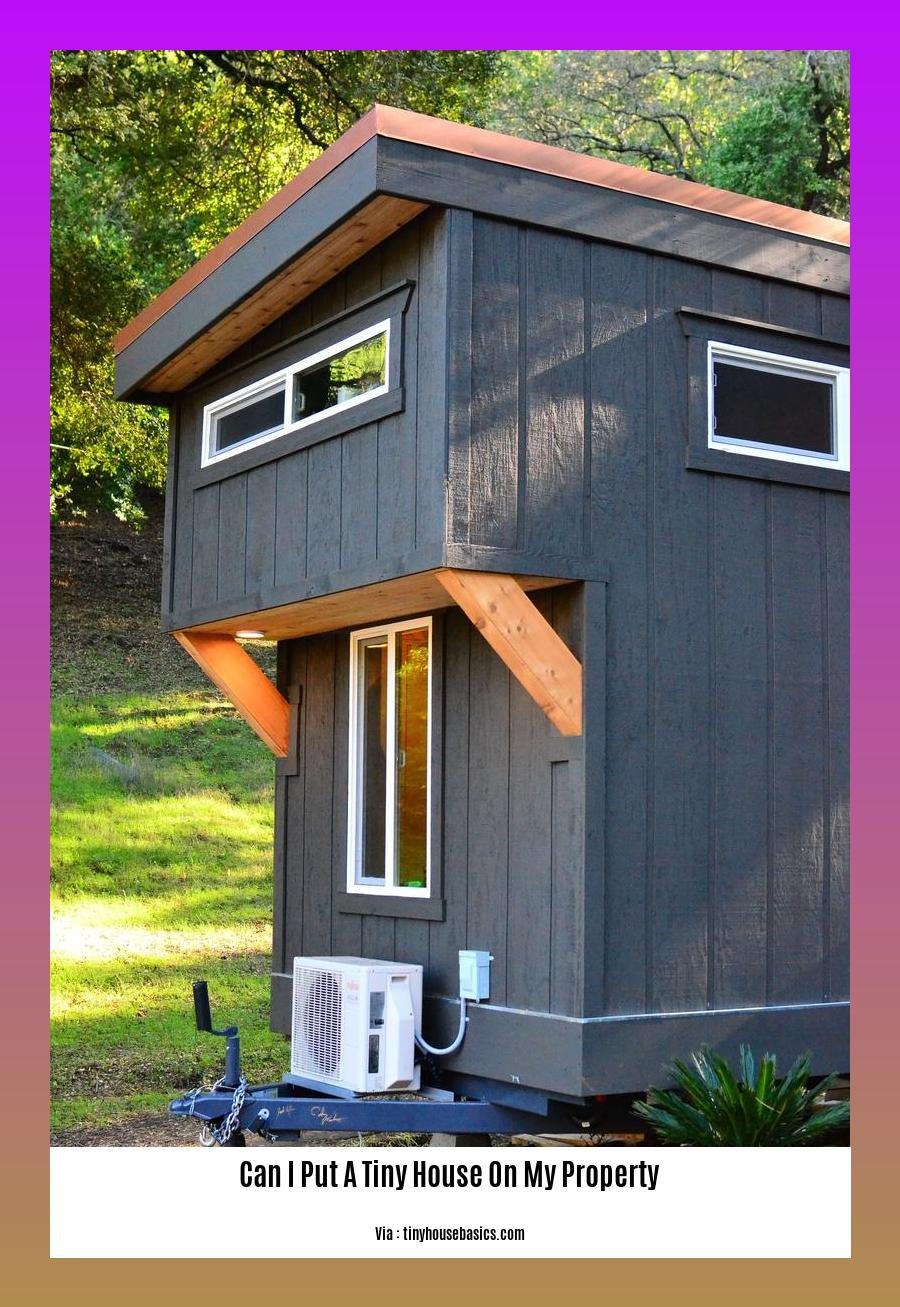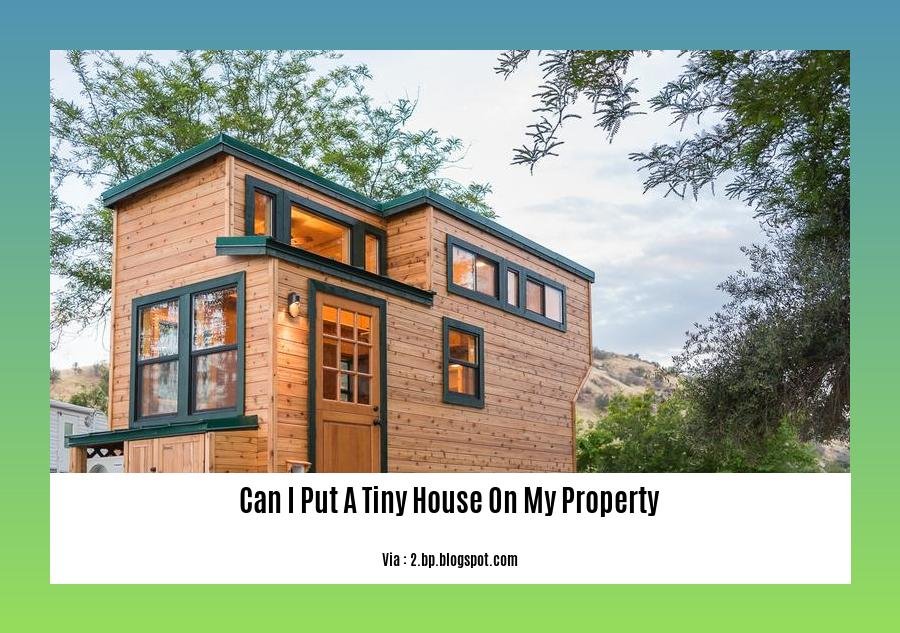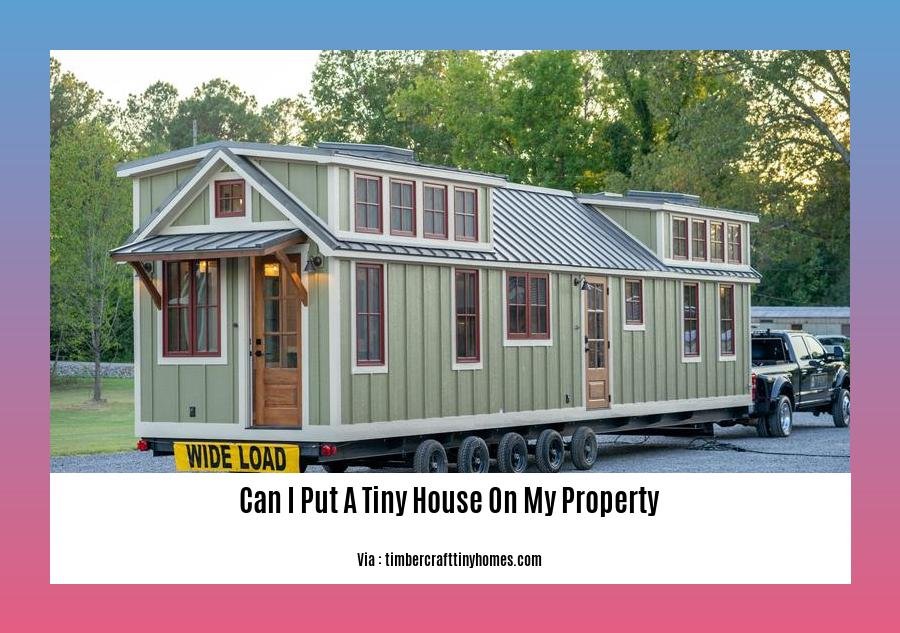Discover the intricacies of placing a tiny house on your property with our comprehensive guide, **Can I Put a Tiny House on My Property? Exploring the Legalities and Considerations**. Dive into the complexities of zoning regulations, building codes, and environmental factors that shape this unique housing option. Uncover inspiring case studies and practical advice to navigate the challenges and unlock the potential of tiny living.
Key Takeaways:
- In most areas, you can put a tiny house on your property, but local laws may require changes to comply.
- The legality of tiny homes depends on the state and if it’s the main residence on the property.
- Certain cities allow tiny homes as extra units on properties with existing houses.
- This is more common in urban areas like Los Angeles, Portland, OR, and Seattle.
Can I Put a Tiny House on My Property?

You may desire a tiny house for many reasons: affordability, sustainability, or the allure of a simple lifestyle. Before you embark on this journey, there’s a crucial question to answer: can you put a tiny house on your property?
Zoning and Local Regulations: The Key Factors
The legality of tiny homes varies drastically across the U.S. Zoning laws often dictate where and how you can place a tiny house. Some cities and counties have specific ordinances addressing tiny homes, while others may not have any regulations at all.
- Check Local Zoning Laws:
- Start by researching zoning laws in your area. Visit the local government website or consult with the planning department to understand the rules. Pay close attention to zoning restrictions for tiny homes, accessory dwelling units (ADUs), or secondary residences.
Types of Tiny Houses: What Are My Options?
Tiny houses come in various shapes and sizes, each with unique features and benefits.
- Conventional Tiny House on a Trailer:
-
This is the most common type. Built on a trailer chassis, it’s easily movable and can be placed on a prepared foundation or rented lot.
-
Park Model Tiny House:
-
Designed for recreational use, they’re often found in campgrounds and RV parks. They may require additional insulation and weatherproofing for year-round living.
-
Container Tiny House:
-
Made from repurposed shipping containers, these tiny homes offer a sturdy and sustainable option. They require careful modification to ensure comfort and livability.
-
Custom Tiny House:
- If you have the budget and expertise, you can design and build your own tiny house from scratch. This option gives you complete control over the design and materials used.
Considerations for Placing a Tiny House on Your Property
- Zoning and Building Codes:
-
Ensure your property is zoned for a tiny house or ADU. Comply with all building codes and regulations related to electrical, plumbing, and structural integrity.
-
Foundation and Utilities:
-
Prepare a suitable foundation for your tiny house, such as a concrete pad or piers. Ensure access to essential utilities like water, electricity, and sewage.
-
Homeowners Association (HOA) Rules:
-
If your property is part of an HOA, check their rules and regulations regarding tiny homes. Some HOAs may have restrictions on the size, appearance, or placement of tiny houses.
-
Financing Options:
- Tiny houses may not qualify for traditional mortgages. Explore alternative financing options such as personal loans, RV loans, or specialized tiny house loans.
Inspiring Case Studies: Making the Tiny House Dream a Reality
- The Urban Escape:
-
In the bustling city of Portland, Oregon, a couple transformed their backyard into a tiny house oasis. Nestled amidst a lush garden, their cozy tiny house offers a sanctuary from the hustle and bustle of city life.
-
The Rural Retreat:
-
On a sprawling ranch in Colorado, a family built a tiny house to accommodate their growing needs. With sweeping views of the Rocky Mountains, their tiny house provides a sense of peace and tranquility.
-
The Coastal Haven:
- Along the scenic coastline of California, a couple designed a tiny house that seamlessly blends with the natural surroundings. With floor-to-ceiling windows and a wrap-around deck, their tiny house offers breathtaking views of the ocean.
Whether you envision a tiny house as your primary residence, a guest house, or a rental property, careful planning and due diligence are essential. By navigating zoning regulations, understanding financing options, and considering your lifestyle needs, you can make your tiny house dream a reality.
-
Want to give your bedroom a luxurious upgrade? Explore our exquisite selection of blanket bed sheet sets, available at prices that won’t break the bank. Click here to discover the perfect set for your dream bedroom.
-
Elevate your special day with our captivating collection of bridal bed sets. From traditional to contemporary styles, find the perfect set to complement your dream wedding. Visit this page to browse our exquisite selection and make your wedding night unforgettable.
-
Indulge in the ultimate comfort and elegance with our luxurious bridal bed sheets. Crafted from the finest materials, these sheets are sure to provide a blissful sleep experience. Discover our exclusive collection here and transform your bedroom into a sanctuary of tranquility.
-
Radiate beauty and grace on your wedding day with our stunning selection of bridal wedding dresses. From classic silhouettes to modern designs, find the perfect dress to make your dreams come true. Visit this page to explore our exquisite collection and make your special day even more memorable.
-
Embark on a journey of exploration and adventure with our comprehensive guide to renting mobile homes. Discover the freedom and flexibility of mobile home living, and find the perfect home away from home for your next vacation or extended stay. Click here to uncover the secrets of mobile home rentals and start your adventure today.
-
Ensure a smooth and successful new home construction project with our detailed checklist. From planning and permits to construction and inspections, we’ve got you covered every step of the way. Access our comprehensive checklist here and make your dream home a reality.
Benefits and Drawbacks: Weighing the advantages and disadvantages of owning a tiny house, including factors like cost-effectiveness, sustainability, and potential challenges.

Tiny houses, with their compact size and minimalist design, have gained popularity as affordable, sustainable, and unconventional living options.
While they offer unique benefits, potential drawbacks should also be considered before making a decision. Let's delve into the advantages and disadvantages of owning a tiny house to help you make an informed choice.
Key Takeaways:
- Pros:
- Cost-effectiveness: Tiny houses are generally more affordable than traditional homes due to their smaller size and simpler construction.
- Sustainability: Tiny houses consume less energy and resources, reducing your environmental impact.
- Mobility: Some tiny houses are built on wheels, allowing you to relocate as desired.
-
Minimalism: Tiny homes encourage a minimalist lifestyle, promoting decluttering and intentional living.
-
Cons:
- Space limitations: Tiny houses offer limited living space, which may not suit those accustomed to larger homes.
- Zoning restrictions: Some areas may have zoning laws that prohibit or restrict tiny houses.
- Financing challenges: Obtaining a mortgage for a tiny house can be difficult due to their unconventional nature.
-
Legal complexities: Tiny houses may not meet standard building codes, leading to potential legal issues.
Ultimately, the decision to own a tiny house is personal. Consider your lifestyle, budget, and long-term goals to determine if this unique housing option aligns with your needs and aspirations.
Source 1: exploring-weight-loss-challenges-weighing-the-benefits-and
Source 2: Weighing Risks and Benefits – ResearchGate
Case Studies: Showcasing successful examples of tiny homes on private property, highlighting innovative designs, efficient layouts, and lessons learned from real-world experiences.
Embracing the Tiny House Lifestyle:
Tiny homes offer a unique perspective on living. They’re designed to utilize every inch of space while providing comfort, functionality, and sometimes even luxury. Here are two inspiring case studies that showcase how individuals and families have successfully integrated tiny homes into their private properties:
1. John and Sarah’s Nomadic Adventure:
John and Sarah, a couple with a passion for travel, embarked on a journey to embrace the tiny house lifestyle. They downsized from their traditional home to a 200-square-foot tiny house on wheels. This empowered them to travel to new destinations, explore diverse landscapes, and appreciate the beauty of minimalism. Living in a tiny home allowed them to save money, reduce their environmental impact, and create lasting memories as they traveled the country.
2. Vicky Grosser’s Eco-Friendly Haven:
Vicky’s dream was to live in a home that reflected her values of sustainability and eco-consciousness. She built a 250-square-foot tiny home using recycled materials and energy-efficient appliances. Her home is nestled on her private property, surrounded by nature. Vicky enjoys the connection with the environment, grows her own vegetables, and actively reduces her carbon footprint. Living in a tiny home has enabled her to live a healthier and more sustainable lifestyle.
Key Takeaways:
- Tiny homes offer unique opportunities for exploring alternative housing solutions.
- They encourage mindful living, reduced environmental impact, and increased affordability.
- Zoning regulations, building codes, and utility considerations vary for tiny homes, so research local laws before construction.
- Tiny homes can be aesthetically pleasing, comfortable, and energy-efficient.
- They promote community connections and foster a sense of togetherness.
Additional Resources:
Tiny Homes: Planning for Affordability and Inclusion
Building Affordable Tiny Homes for the Homeless
Legal Considerations: Addressing legal issues related to tiny houses, such as property taxes, insurance coverage, and potential legal challenges or restrictions.
When it comes to tiny houses, legality is a tangled web of zoning regulations, building codes, and legal challenges. Before you take the plunge, let’s untangle the legal knots.
Property Taxes and Insurance
Tiny houses, often classified as personal property, may be subject to different tax rates and insurance policies than traditional homes. Check with your local authorities to understand the tax implications and seek specialized insurance coverage tailored to tiny homes. This ensures your tiny home is protected and you’re not caught off guard by unexpected expenses.
Zoning Regulations
Zoning regulations determine where and how tiny houses can be placed. Some areas have specific zoning laws for tiny homes, while others may require variances or special permits. It’s vital to research local zoning regulations to ensure your tiny home complies. This prevents potential legal challenges from neighbors or authorities and ensures a smooth installation process.
Legal Challenges
Tiny houses can sometimes face legal challenges due to their unconventional nature. Neighbors may raise concerns about aesthetics, property values, or increased traffic. Zoning laws may also restrict tiny houses in certain areas. To avoid legal hassles, communicate with your neighbors and community about your tiny home plans. Address their concerns and work towards a mutually agreeable solution.
Key Takeaways:
- Zoning regulations dictate where tiny houses can be placed. Check local laws to avoid legal issues.
- Tiny houses are often taxed as personal property. Confirm local rates and seek specialized insurance.
- Potential legal challenges may arise from neighbors or authorities. Open communication is key.
- Neighbors’ concerns can be addressed through open communication and compromise.
Relevant URL Sources:
- Tiny House Laws by State USA – The Updated Guide 2023
- State-by-state Tiny Home Regulations Explained For Beginners
FAQ
Q1: Can I legally place a tiny house on my property?
A1: The legality of placing a tiny house on your property depends on local regulations, including zoning laws and building codes. It’s advisable to check with the local authorities to obtain the necessary permits and approvals before proceeding.
Q2: Are there any specific zoning restrictions for tiny houses?
A2: Zoning regulations vary across jurisdictions. Some areas may have restrictions on the size, location, and use of tiny houses. It’s essential to research local zoning laws to ensure your tiny house complies with the requirements.
Q3: What are the safety and habitability standards for tiny houses?
A3: Tiny houses must meet certain safety and habitability standards, including minimum square footage, ceiling height, and access to essential utilities like electricity, water, and sewage. Building codes provide guidelines for ensuring the structural integrity and safety of tiny houses.
Q4: What are the potential challenges of placing a tiny house on my property?
A4: Zoning restrictions and building codes can pose challenges for tiny home development. Additionally, obtaining the necessary permits and approvals from local authorities can be a lengthy process. Resistance from neighbors or objections regarding the impact of tiny houses on the community may also arise.
Q5: Can I place a tiny house on rented land?
A5: The possibility of placing a tiny house on rented land depends on the terms of the lease agreement and local regulations. It’s essential to discuss your plans with the landowner and obtain their consent before proceeding. Zoning laws may also restrict the placement of tiny houses on rented land.
- Stovetop Backsplash Ideas: Stylish Protection for Your Kitchen Cooking Zone - December 23, 2025
- Embossed Backsplash Tile Kitchen: Add Texture And Style - December 22, 2025
- Ceramic Tile Backsplash Ideas for Your Kitchen Remodel - December 21, 2025










